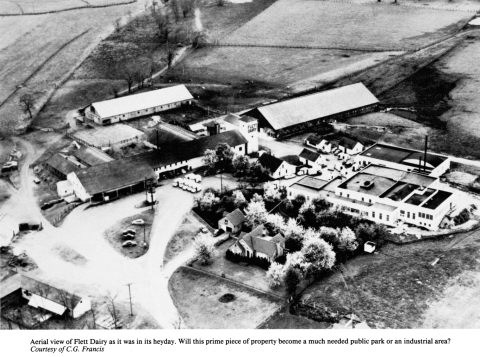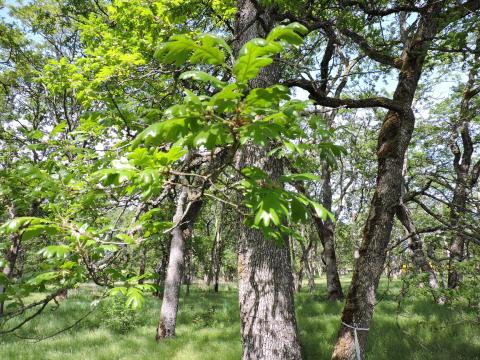CPTC's Outdoor Learning Laboratory - Flett Property
In 1993, Clover Park Technical College (CPTC) purchased 110 acres of a former dairy farm (Flett Dairy) adjacent to its main campus in Lakewood. The property is called the Natural Resources Laboratory and Research Park at Flett Creek (also known as the Flett Property), which is used to train students enrolled in its Environmental Sciences and Technology program. The outdoor lab facility includes approximately 80 acres Flett Creek Wetland, a large oak savannah, and a strip of coniferous forest. This diversity of ecosystems makes it an ideal site for students to practice plant identification, wetland delineation, mapping and surveying, water quality testing, forestry measurements, and other environmental monitoring techniques.
The Flett Property is on the traditional land of the Puget Sound Salish peoples belonging to the Steilacoom, Puyallup, Nisqually, and Squaxin Island tribes and bands. These ancestral lands were ceded to the U.S. government with the signing of the Medicine Creek Treaty, which was broken shortly thereafter. We honor the traditional caretakers of this land and welcome their input and involvement in restoring the land to a more natural state.
John Flett first arrived in the Puget Sound area in 1841 and settled in what is now Lakewood near a creek that later received his own name as its title (i.e., Flett Creek). At this point, the land was open and in a historically natural state with perhaps some land cleared for agriculture. Flett’s son-in-law, George Chapman and his wife, Annie, eventually converted this property into farmland and opened up the Flett Dairy in 1903. Chapman later sold it in 1910 to Robert Portman, a Swiss dairy farmer, who died only a few years later in 1913. Portman’s widow, Mary B. Gratzer married Gottfried Fuchs, and together they built the Flett Dairy into one of Washington’s largest dairies. After the death of Mary (in 1966) and Gottfried Fuchs (in 1976), the Mary Fuchs Foundation sold portions of the dairy for “charitable, educational, scientific, literary or religious purposes.” A portion of the dairy property was acquired in 1993 by CPTC as an outdoor lab facility for the Environmental Sciences and Technology program, while much of the land around it was developed for businesses and housing. At its dedication as an outdoor lab facility in 1994, CPTC official Nancy White called the Flett Property a “sanctuary in the middle of the city.”

References:
Lakewood Historical Society. 2017. Dairy to “Sanctuary”. Prairie Gazette (The Official Publication of the Lakewood Historical Society. Fall 2017 issue. pp. 1 & 4.
Lakewood Historical Society. 2017. The Flett Family’s Saga. https://www.lakewoodhistorical.org/programs/details.php?pageid=30
There is a large stand of Garry Oak or Oregon White Oak (Quercus garryana) on the Flett Property. It is believed to be the largest stand of Garry oaks within an incorporated city in Washington State, numbering more than 700 mature trees. When the savannah was converted to a dairy farm, dense European pasture grass species replaced beautiful native wildflowers. As a result, young oak trees and wildflowers have difficulty growing through the thick grassy thatch. There are also invasive plant species present in or adjacent to the oak savannah, with scotch broom (Cytisus scoparius) and Himalayan blackberry (Rubus armeniacus) being the most abundant. Despite the pasture grasses and invasive species, some of the native wildflowers remain, along with many other native forbs, shrubs, and trees.

Flett Wetland begins on the Flett Property. It is known to be a birding hotspot, particularly for migrating waterfowl. There are many year-round resident bird and wildlife species in the wetland. River otters (Lontra canadensis), beavers (Castor canadensis), red-tailed hawks (Buteo jamaicensis), osprey (Pandion haliaetus), turtles, and many waterfowl are often observed. There is also a large variety of plant species present in the wetland. However, the wetland is dominated by invasive reed canary grass (Phalaris arundinacea), along with native cattail (Typha latifolia) and swamp smartweed (Persicaria hydropiperoides). The dominating presence of these plant species may be due to the disturbance to the wetland when Flett Dairy had drained the area for grazing use.
Upstream of the wetland, there are four stormwater detention ponds managed by the City of Tacoma. While not wetlands themselves, these detention ponds do provide some similar habitat and ecosystem functions as wetlands, including nesting and foraging grounds, water storage, and water quality improvement. It should be noted that these ponds are not part of CPTC’s Flett Property, but faculty and students do have opportunities to do environmental monitoring in them. Water from the detention pond #4 is pumped into CPTC’s portion of Flett Wetland. Water is stored in the wetland and moves downstream passing under Lakewood Drive. Flett Wetland continues between Lakewood Drive and Bridgeport Way under ownership of private property and City of Lakewood. After passing under Bridgeport Way, the water enters the valley of the Flett Creek stream channel and flows downstream into Chambers Creek, eventually reaching Chambers Bay and Puget Sound.
Many wildlife species are commonly observed on the property – including osprey (Pandion haliaetus), red-tailed hawks (Buteo jamaicensis), owls, coyotes (Canis latrans), beavers (Castor canadensis), great blue herons (Ardea herodias), among many others. Although not on the Flett Property, osprey nest annually on the communications tower located on CPTC’s campus right across the street. Pumpkinseed and bluegill fish (Lepomis spp.), bass (Micropterus spp.), threespine stickleback (Gasterosteus aculeatus), and cutthroat trout (Oncorhynchus clarki) are also residents of Flett Wetland and Flett Creek. Some fish and wildlife photos are shown below.
Students in CPTC’s Environmental Sciences and Technology program gain hands on experience with environmental monitoring and restoration techniques. Restoration efforts performed by students include invasive species removal and planting native species. Native species provide increased diversity within the habitats and trees planted in the riparian zone of the wetland will provide cooler water temperature for juvenile salmon residing in the wetland.
In addition to students completing habitat stewardship, CPTC has been hosting monthly habitat stewardship events on the Flett Property with community volunteers attending. The dates and other relevant information for this year’s habitat stewardship events are on the flyer below.
Clover Park Technical College offers two associate degree programs in Environmental Sciences & Technology and a bachelor of applied science degree in Environmental Sciences.
Learn about our associate degrees in Environmental Sciences & Technology.
Learn about our bachelor of applied science degree in Environmental Sciences.
For as long as she can remember, Marcia Wilson wanted to be a scientist. But as a published writer who had focused on arts and literature, pursing a humanities degree seemed like a more sensible path.
Scotch Broom seems impossible to kill, but in 2021 Dr. Faust found something doing exactly that...
Marcia Wilson was birdwatching in the hopes of tracking down new species for the bird list at Clover Park Technical College when thoughts of pesky ospreys and ulcer-inspiring green herons braked with a screech.

